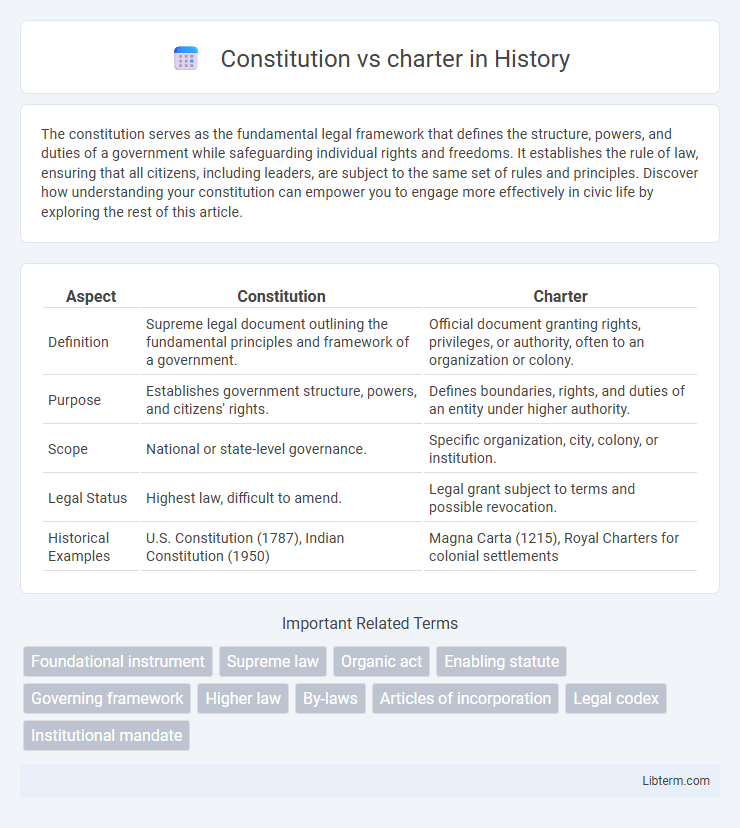The constitution serves as the fundamental legal framework that defines the structure, powers, and duties of a government while safeguarding individual rights and freedoms. It establishes the rule of law, ensuring that all citizens, including leaders, are subject to the same set of rules and principles. Discover how understanding your constitution can empower you to engage more effectively in civic life by exploring the rest of this article.
Table of Comparison
| Aspect | Constitution | Charter |
|---|---|---|
| Definition | Supreme legal document outlining the fundamental principles and framework of a government. | Official document granting rights, privileges, or authority, often to an organization or colony. |
| Purpose | Establishes government structure, powers, and citizens' rights. | Defines boundaries, rights, and duties of an entity under higher authority. |
| Scope | National or state-level governance. | Specific organization, city, colony, or institution. |
| Legal Status | Highest law, difficult to amend. | Legal grant subject to terms and possible revocation. |
| Historical Examples | U.S. Constitution (1787), Indian Constitution (1950) | Magna Carta (1215), Royal Charters for colonial settlements |
Introduction to Constitutions and Charters
Constitutions establish the fundamental legal framework and principles governing a nation or organization, while charters serve as formal documents granting rights and defining governance structures for specific entities. Constitutions typically outline the separation of powers, fundamental rights, and the scope of government authority, providing a comprehensive foundation for law and order. Charters, often used by municipalities, corporations, or institutions, specify the organization's purpose, powers, and operational guidelines within a more limited context.
Historical Origins of Constitutions and Charters
Constitutions historically emerged during the Enlightenment as foundational legal frameworks establishing government structures and citizens' rights, with early examples like the Magna Carta (1215) serving as charters limiting monarchic power. Charters originated in medieval England as grants or privileges issued by sovereigns to towns, companies, or individuals, primarily focusing on specific rights or land usage rather than comprehensive governance. The evolution from charters to modern constitutions reflects a shift from delegated privileges to systematic, codified laws defining nation-state authority and individual liberties.
Defining a Constitution: Core Features
A constitution establishes the fundamental principles and legal framework that govern a state, outlining the distribution of powers, functions of government branches, and citizens' rights. It serves as the supreme law, binding all institutions and individuals within the jurisdiction, often including mechanisms for amendment and interpretation. Core features include supremacy, written or codified form, and the ability to regulate the relationship between the state and its citizens.
Understanding a Charter: Key Characteristics
A charter serves as a foundational document outlining the framework, rights, and responsibilities for organizations or municipalities, often granting legal authority and defining governance structures. Unlike a constitution, which establishes the supreme law of a nation with broad, overarching principles, a charter is typically more specific and operational in nature. Key characteristics of a charter include explicit delegation of powers, detailed procedural rules, and clear terms for amendments or revocations.
Legal Authority and Supremacy
A constitution is the supreme legal authority that establishes the fundamental principles, structures, and powers of a state, overriding all other laws and charters. Charters typically grant specific rights or privileges to organizations, municipalities, or corporations but operate under the framework of the constitution. The constitution's supremacy ensures that any charter conflicting with constitutional provisions is invalid and subordinate to constitutional law.
Scope and Application in Governance
Constitutions provide a comprehensive framework for national governance, defining the structure, powers, and duties of government institutions while protecting citizens' fundamental rights on a broad scale. Charters typically serve a more specific purpose, outlining the organization and authority of local governments, municipalities, or particular entities within a defined jurisdiction. The scope of constitutions is extensive and supreme, whereas charters have limited application confined to the entity or region they govern.
Amending Processes: Constitution vs Charter
Constitutions typically require a rigorous amending process involving supermajority votes in legislatures or referenda, ensuring foundational stability and broad consensus for changes. Charters often have more flexible amendment procedures, allowing local authorities or organizations to make modifications with simpler majority approvals or specified administrative actions. The differing amendment protocols reflect the constitutions' role as supreme legal frameworks versus charters' function as governing documents for municipalities or entities with adaptable governance needs.
Impact on Rights and Freedoms
Constitutions provide a foundational legal framework that explicitly guarantees fundamental rights and freedoms, often enshrining protections against government overreach and ensuring judicial enforceability. Charters typically focus more narrowly on civil rights within specific contexts, such as workplace rights or organizational governance, offering targeted protections without the broad constitutional authority. The impact of a constitution on rights and freedoms tends to be more comprehensive and durable, shaping national legal standards and individual liberties on a systemic level.
Case Studies: Countries with Constitutions vs Charters
Countries like the United States and India operate under constitutions that provide detailed frameworks for governance, fundamental rights, and separation of powers. In contrast, countries such as Hong Kong and Qatar use charters which tend to offer more flexible governance structures with less emphasis on entrenched rights and rigid separation of powers. Case studies reveal that constitutional countries often experience stronger judicial review and institutional stability, while charter-based countries may allow for quicker policy adaptability but face challenges in consistent legal interpretation.
Choosing Between a Constitution and a Charter
Choosing between a constitution and a charter depends on the scope and rigidity required for governance documents. Constitutions typically provide a comprehensive legal framework with detailed principles and procedures, making them suitable for sovereign states or large organizations seeking long-term stability and authority. Charters offer more flexibility and simplicity, often used by smaller entities or specialized organizations prioritizing adaptable governance structures over exhaustive regulation.
Constitution Infographic

 libterm.com
libterm.com